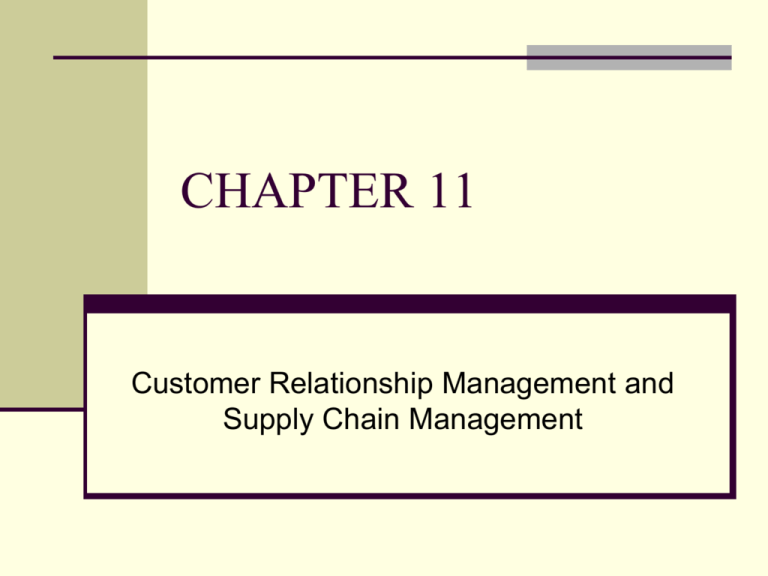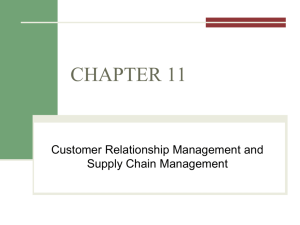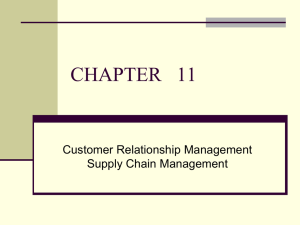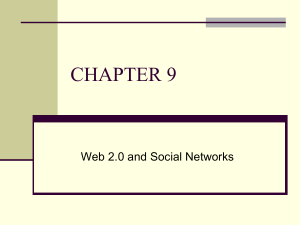Supply chain management
advertisement

CHAPTER 11 Customer Relationship Management and Supply Chain Management CHAPTER OUTLINE 11.1 Defining Customer Relationship Management 11.2 Operational Customer Relationship Management Systems 11.3 Analytical Customer Relationship Management Systems 11.4 Other Types of Customer Relationship Management Systems 11.5 Supply Chains 11.6 Supply Chain Management 11.7 Information Technology Support for Supply Chain Management LEARNING OBJECTIVES 1. Define customer relationship management and collaborative CRM, and identify the primary functions of both processes. 2. Describe the two major components of operational CRM systems, list three applications used in each component, and provide at least one example of how businesses use each application. 3. Describe analytical CRM systems, and describe four purposes for which businesses use these systems. LEARNING OBJECTIVES (continued) 4. Define mobile CRM systems, on-demand CRM systems, and open-source CRM systems, and identify one main advantage and one main drawback of each. 5. Define the term, supply chain, and describe the three components and the three flows of a supply chain. LEARNING OBJECTIVES (continued) 6. Identify two major challenges in setting accurate inventory levels throughout the supply chain, and describe three popular strategies to solve supply chain problems. 7. Define the terms electronic data interchange (EDI), extranet, and portal, and explain how each of these applications helps support supply chain management. Chapter Opening Case: The Next Step in Customer Relationship Management Source: Maxx-Studio/Shutterstock VIP Auto Appearance Center (IT’s About Business 11.1) Source: Thank You/Shutterstock 11.1 Defining Customer Relationship Management Source: Kzenon/Shutterstock From Neighborhood Stores……. © MONKEY BUSINESS-LBR/Age Fotostock America, Inc. Personal To Today….. Mobile population The Web Giant malls Impersonal The Need for CRM It costs six times more to sell to a new customer than to sell to an existing one. A typical dissatisfied customer will tell 8-10 people. By increasing the customer retention rate by 5%, profits could increase by 85%. Odds of selling to new customers = 15%, compared to the odds of selling to existing customers (50%) 70% of complaining customers will remain loyal if their problem is solved Tenets of CRM One-to-one relationship between a customer and a seller. Treat different customers differently. Keep profitable customers and maximize lifetime revenue from them. Lifetime Customer Value Source: Kzenon/Shutterstock Customer Touch Points Data Consolidation Accounting HR Finance Customer Marketing MIS Data Consolidation = 360-Degree View of Customers 11.2 Operational Customer Relationship Management Systems Two major components of operational CRM Customer-facing applications Customer-touching applications Customer-Facing Applications Customer service and support Sales force automation Marketing Campaign management © Mustafa Almir Mahmoud/Age Fotostock America, Inc. Refining the Call Center (IT’s About Business 11.3) © Dinodia/Age Fotostock America, Inc. Marketing Cross selling Up selling Bundling Source: © Amy Eira/PhotoEdit Customer-Touching Applications Search and comparison capabilities Technical and other information and services Customized products and services Loyalty programs Source: © Spencer Grant/PhotoEdit 11.3 Analytical Customer Relationship Management Systems Analytical CRM systems analyze customer behavior and perceptions in order to provide actionable business intelligence. © VISION/Age Fotostock America, Inc. The Relationship Between Operational CRM and Analytical CRM Customer-facing Applications • Sales • Marketing • Customer Service and Support • Campaign Management Customer Data Warehouse Customer-touching Applications • • • • • • • Search and Comparison Customized Products Technical Information Personalized Web Pages FAQ E-mail / Auto Response Loyalty Programs • • • • Data Mining Decision Support Business Intelligence OLAP 11.4 Other Types of Customer Relationship Management Systems On-demand CRM Mobile CRM Source: Image Source Limited; J-C & D. PRATT/PhotoNonStop/Glow Images) Open-source CRM Mobile CRM on a Smartphone (IT’s About Business 11.4) Source: Oleksiy Mark/Shutterstock 11.5 Supply Chains Source: jon le-bon/Shutterstock Generic Supply Chain Supply Chain (recall Figure 1.5) The Flows of the Supply Chain Material flows Information flows © Toh Kheng Ho/Age Fotostock America, Inc. Financial flows 11.6 Supply Chain Management Supply chain management (SCM) Interorganizational information system (IOS) © Toh Kheng Ho/Age Fotostock America, Inc. Push Model Pull Model Source: © Milan Zeremski/iStockphoto Problems Along the Supply Chain Poor customer service Poor quality product High inventory costs Loss of revenues The Bullwhip Effect Order Quantity Order Quantity Order Quantity Order Quantity Time Time Time Time Customer Sales Retail Orders To Wholesaler Wholesaler Orders to Manufacturer Manufacturer Orders to Supplier Solutions to Supply Chain Problems Using inventories Just-in-time inventory Information sharing Vendor-managed inventory 11.7 Information Technology Support for Supply Chain Management Electronic data interchange (EDI) Extranets EDI Benefits Minimize data entry errors Length of messages are shorter Messages are secured Reduces cycle time Increases productivity Enhances customer service Minimizes paper usage and storage EDI Limitations Significant initial investment to implement Ongoing operating costs are high due to the use of expensive, private VANs Traditional EDI system is inflexible Long startup period Multiple EDI standards exist Comparing Purchase Order Fulfillment Without EDI Source: Drawn by E. Turban Comparing Purchase Order Fulfillment With EDI Source: Drawn by E. Turban Extranets The main goal of extranets is to foster collaboration between business partners. An extranet is open to selected B2B suppliers, customers and other business partners. The Structure of an Extranet Types of Extranets A company and its dealers, customers or suppliers An industry’s extranet Joint ventures and other business partnerships Chapter Closing Case • The Problem • The Solution • The Results











